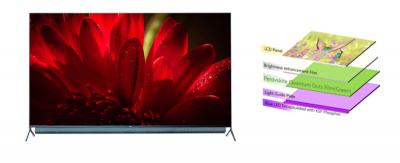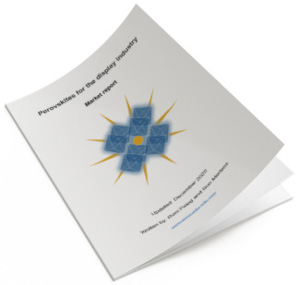Perovskite Quantum Dots (PQDs) - Page 6
Researchers design flexible perovskite quantum dot solar cell with 15.1% efficiency
An international research team has developed a flexible quantum dot solar cell based on all-inorganic cesium-lead iodide (CsPbI3) perovskite.

The researchers built the cell by integrating quantum dots (QDs) with high surface areas into a thin hybrid interfacial architecture (HIA) and by adding phenyl-C61-butyric acid methyl ester (PCBM), which is known as one of the best-performing electron acceptors commonly used in organic photovoltaic devices, into the CsPbI3 quantum dot layer.
TCL and Zhijing Nanotech collaborate on pQD solutions for LCD TVs
China-based Zhijing Nanotech develops perovskite-QD film (PQDF) technologies for the display industry, and the company demonstrated its first prototypes in 2018.

Perovskite-Info has talked with the company's management, which updated us that it recently concluded a successful pilot with TCL. TCL, in collaboration with Zhijing Nanotech, produced 500 75-inch QD-enhanced LCD TVs (TCL 4K 75M10) with Zhijing's PQDF films. The company reports that the TVs featured a wide color gamut, 147% BT709 - which is higher than most QD TV's on the market, and higher than TCL's original 75M10 TVs.
New! Don't miss the Perovskite for the Display Industry Market Report
Perovskite-Info is proud to present our first market report, The Perovskite for the Display Industry Market Report. This market report, brought to you by the world's leading perovskite and OLED industry experts, is a comprehensive guide to next-generation perovskite-based solutions for the display industry that enable efficient, low cost and high-quality display devices.
Reading this report, you'll learn all about:
- Perovskite materials and their properties
- Perovskite applications in the display industry
- Perovskite QDs for color conversion
- Prominent perovskite display related research activities
The report also provides a list of perovskite display companies, datasheets and brochures of pQD film solutions, an introduction to perovskite materials and processes, an introduction to emerging display technologies and more.
Quantum Solutions demonstrates its green perovskite QD film for LCD color conversion
UK-based Quantum Solutions published this video below that demonstrates its latest perovskite QD film for LCD color conversion:
Quantum Solutions now offers its QDot SharpGreen Perovskite QDs Film, which is a polymer composite with embedded QDot SharpGreen Perovskite QDs. It is designed to be used in LCD backlighting units and sensor devices for X-rays and UV lights. The material has green emission 520-535 nm (depending on the concentration), high PLQY (up to 80-100 %) and narrow FWHM ( 70-80 % of initial photoluminescence within 1000 hours of exposing by heat (85 °C and blue light 10 mW/cm2 exposure) and high relative humidity (90 % RH at 60 °C).
Perovskite QD films get closer to market - Avantama qualifies its green pQD display film
An exciting application for perovskite QDs, which is likely to be the first commercial adoption of pQDs, is for the display market - films that convert blue LED LCD backlight to green.
Switzerland-based nanomaterial developer Avantama told us that the company passed the OEM qualification with its green pQD film, together with a KSF phosphor solution on the LED chip. Avantama expects the first commercial LCD display to adopt this solution to hit the market in 2021.
Researchers achieve breakthrough with blue LEDs based on perovskite quantum dots
Research using the Canadian Light Source (CLS) at the University of Saskatchewan could help bring perovskite QDs display technology closer to commercilization.
Quantum dots are nanocrystals that glow, a property that scientists have been working with to develop next-generation LEDs. When a quantum dot glows, it creates very pure light in a precise wavelength of red, blue or green. Conventional LEDs, found in TV screens today, produce white light that is filtered to achieve desired colors, a process that leads to less bright and muddier colors.
Nanolumi demonstrates several display prototypes that adopt the company's perovskite QD films
Singapore-based Nanolumi unveiled several display prototypes that adopt the company's perovskite quantum dots films.
In the video above, you can see a 32" mini-LED display, a 24" edge-lit LCD monitor and a 10-inch tablet. The company says its cadmium-free films combine the industry's narrowest color spectrum.
A new approach could result in efficient and stable perovskite QLEDs
Researchers at the College of Materials Science and Engineering at Nanjing University of Science and Technology in China have developed a technique that greatly enhances perovskite QLEDs' performance and stability compared to single interface processing.
 The structure of QLED based on QD films passivated without (b) and with passivation (c). Image from Nature Communications
The structure of QLED based on QD films passivated without (b) and with passivation (c). Image from Nature Communications
The team proposed a bilateral passivation strategy through passivating the top and bottom interface of the QD film with organic molecules.
Q&A with the CEO of perovskite developer Helio Display Materials
Helio Display Materials, based in the UK, was spun-off from both Oxford and Cambridge University, to commercialize photoluminescent and electroluminescent perovskite-based materials for the display industry.

Following is an interview with Helio's CEO, Simon B. Jones, discussing the company's technology and business.
Researchers use perovskite QDs to design a device that mimics brain cells used for human vision
University of Central Florida researchers are helping to close the gap separating human and machine minds, using a technology based on perovskite quantum dots. In a recent study, a UCF research team showed that by combining two promising nanomaterials into a new superstructure, they could create a nanoscale device that mimics the neural pathways of brain cells used for human vision.
"This is a baby step toward developing neuromorphic computers, which are computer processors that can simultaneously process and memorize information," said Jayan Thomas, an associate professor in UCF's NanoScience Technology Center and Department of Materials Science and Engineering. "This can reduce the processing time as well as the energy required for processing. At some time in the future, this invention may help to make robots that can think like humans."
Pagination
- Previous page
- Page 6
- Next page




